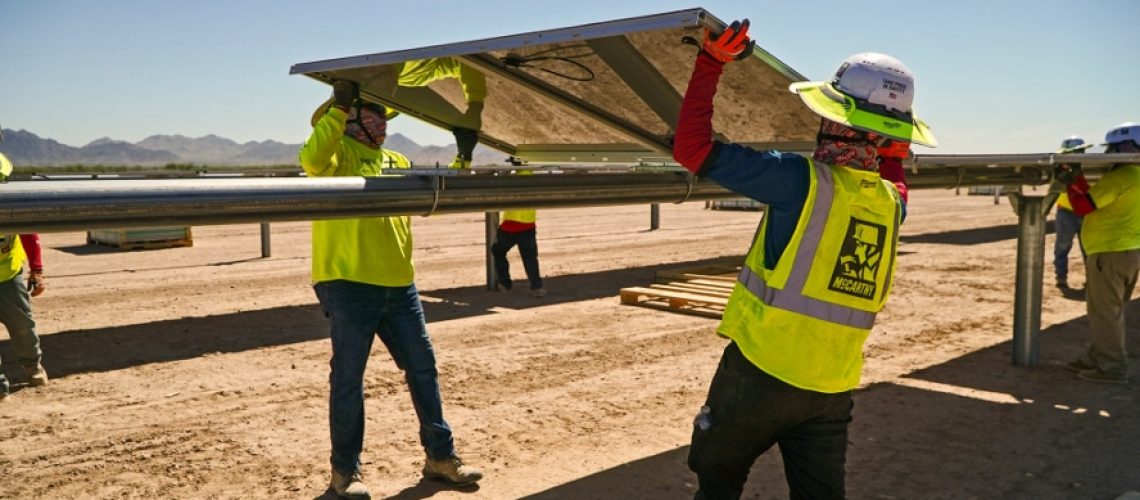As the solar industry continues to grow, finding talent to complete the necessary work keep projects moving has become a critical issue. To help fill labor gap, companies are pushing for more training programs, while the federal government has helped incentivize workforce development programs.
The Inflation Reduction Act (IRA) established a 30% investment tax credit (ITC) for 1 MW and larger solar projects, which is tied to meeting requirements for prevailing wages and apprenticeship participation.
Prevailing wage standards specify hourly wage rates for workers (including apprentices) in skilled construction trades, requiring contributions to workers’ benefits such as healthcare, paid time off, retirement funds and apprenticeship training.
To get the 30% tax credit, companies must have a registered apprenticeship program (RAP), either state or federal. Federal regulations require apprenticeships to be at least one year long with on-the-job experience and related instruction, with a total of at least 144 hours per year of instruction and 2,000 hours per year on the job. State regulations are similar but can be more stringent in some cases.
Companies must meet percentage requirements related to the number of apprentices and mentors on a jobsite to earn these credits. You can learn more about that in our story about growing the solar workforce from last year.
However, jobsites aren’t the only area where the solar industry is coming up short in terms of available labor—it’s all levels. We tapped into our coveted contact list to gauge the solar workforce challenges from industry experts. Here’s what they had to say.
Will prevailing wage requirements cause changes elsewhere in a project’s budget?
Mike Hall, CEO of Anza Renewables

“The industry has been ready for the prevailing wage requirements for some time, and we’ve already seen labor costs increase. I think budgets have been taking into account the prevailing wage requirement in the IRA for a bit now. I don’t expect it’s going to be a big issue – everybody’s ready for it.”
Nate Owen, founder and CEO of Ampion Renewable Energy

“While prevailing wage requirements may cause changes in a project’s budget, solar developers and investors who meet prevailing wage requirements are eligible for a 30% Investment Tax Credit (ITC). To get this ITC, laborers and mechanics employed by the taxpayer or any contractor or subcontractor must be paid the prevailing wage for construction or repairs for that location. The extra financial benefit to developers will likely more than offset the additional cost, making it an attractive component of the IRA.”
Austin Willenbrock, senior manager of strategic partnership and EPC delivery at Inovateus Solar

“Prevailing wage requirements will inevitably affect project budgets moving forward, potentially leading to increased labor costs especially in markets with more lenient labor requirements. It is essential for Inovateus Solar, as well as other developers/EPC companies, to carefully plan and allocate budgets to accommodate these requirements without compromising the overall project feasibility.”
What are the biggest needs in terms of labor / workforce development for the market? And any suggestions on how to get there?
John Shaw, utility sales manager, Pacific Region, at Trina Solar

“Addressing the labor and workforce needs in the solar market requires a comprehensive strategy in 2024. The push for more training programs at a national scale is crucial, reflecting the industry’s rapid growth and the demand for skilled professionals. The emphasis on national standards underscores the need for a unified and consistent approach to workforce training and certification, ensuring a high-quality labor force across diverse locations and training providers. Partnerships between industry stakeholders, educational institutions, and government bodies can facilitate the development of effective training programs that align with industry needs and evolving technological advancements.
“The ratio, labor hours, and participation ratios outlined in the IRA’s apprenticeship requirement may contribute to strengthening the collective skill set of the industry’s workforce.”
Ben Lipari, assistant VP of resource development at Alliant Energy

“Given the rapid growth in sustainable energy construction, proper training and experience are key to ensuring projects can be completed safely, on-time and on-budget. We have partnered closely with local union halls and technical colleges to support craft apprenticeships and expand worker training opportunities. At several of our construction sites, we have welcomed students from technical college training programs and local high school tech ed classes to promote learning activities and enhance career development opportunities.”
Aaron Halimi, president and founder of Renewable Properties

“We’re almost fully staffed, but we partner with EPCs, and it’s increasingly difficult to find experienced solar and energy storage EPCs, electricians, and site diligence report contractors. As mentioned earlier, development and site acquisition have also become more challenging, requiring more experienced staff. We’ve found success in training recent college graduates who are passionate about fighting climate change. We’re also attracting new team members transitioning from other industries, such as telecommunications infrastructure, oil and gas developers, and real estate development.”
Matt Beasley, chief commercial officer at Silicon Ranch

“As the solar industry has expanded, so too has our need for talent. Fortuitously, the growing demand for labor can actually support the social license by inspiring IPPs and contractors to hire subcontractors and craft workers from the local community, both for construction and for ongoing operations and maintenance activities. Through our Regenerative Energy® model of land management, Silicon Ranch has been recruiting livestock managers from the rural communities where we locate to help manage the land we own. Through this effort, we are demonstrating that the solar industry can help build traditional jobs for the rural generation to come, jobs that are obtainable and relatable to the rural workforce. If we don’t do anything new, the old jobs will go away on their own, and homegrown talent will move somewhere else.
“Finally, at Silicon Ranch we’re committed to prioritizing hiring military veterans whenever possible to help grow the overall talent pool for the industry. We work closely with organizations such as Hiring Our Heroes and Solar Ready Vets. In fact, nearly 10% of my Silicon Ranch colleagues are military veterans, almost double the national average.”
Tags: Alliant Energy, Ampion, Anza, Inovateus Solar, prevailing wages, Renewable Properties, Silicon Ranch, solar apprenticeship programs, Trina Solar, utility-scale, workforce



